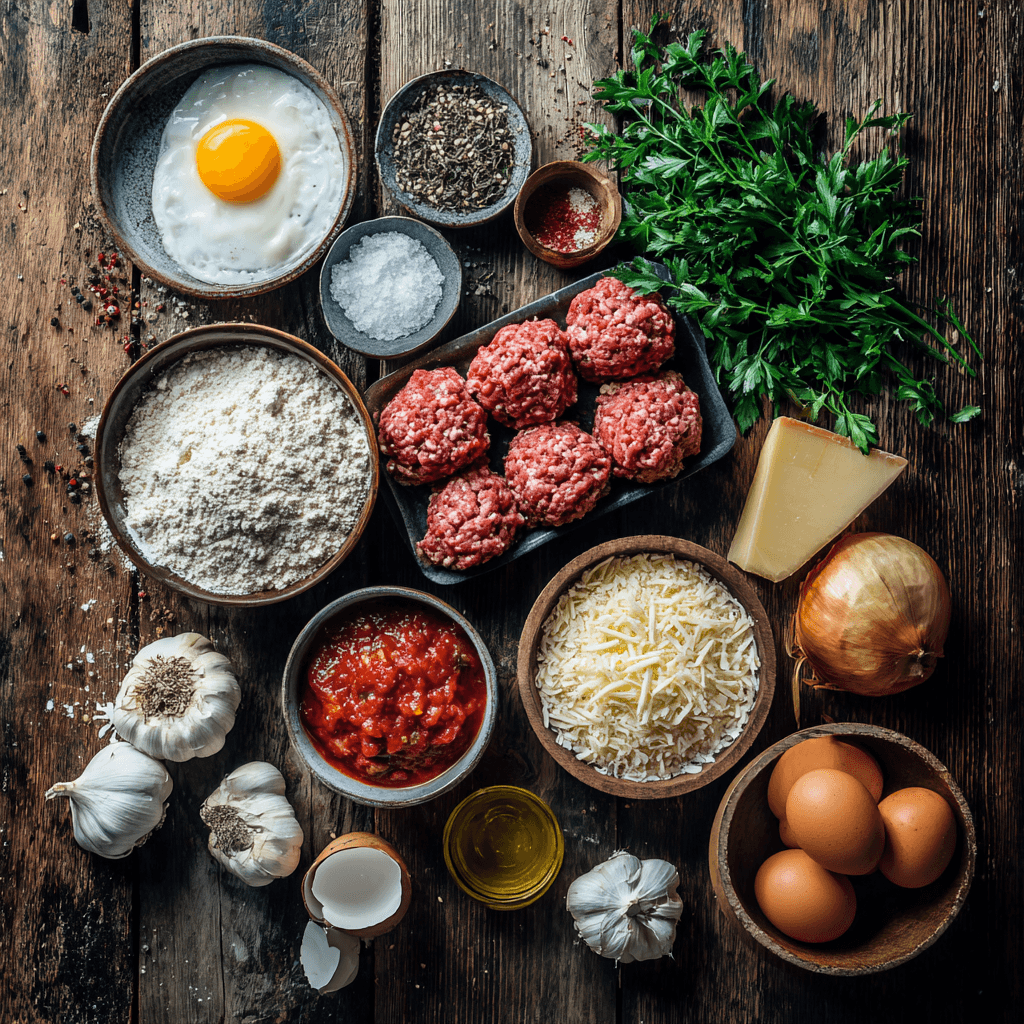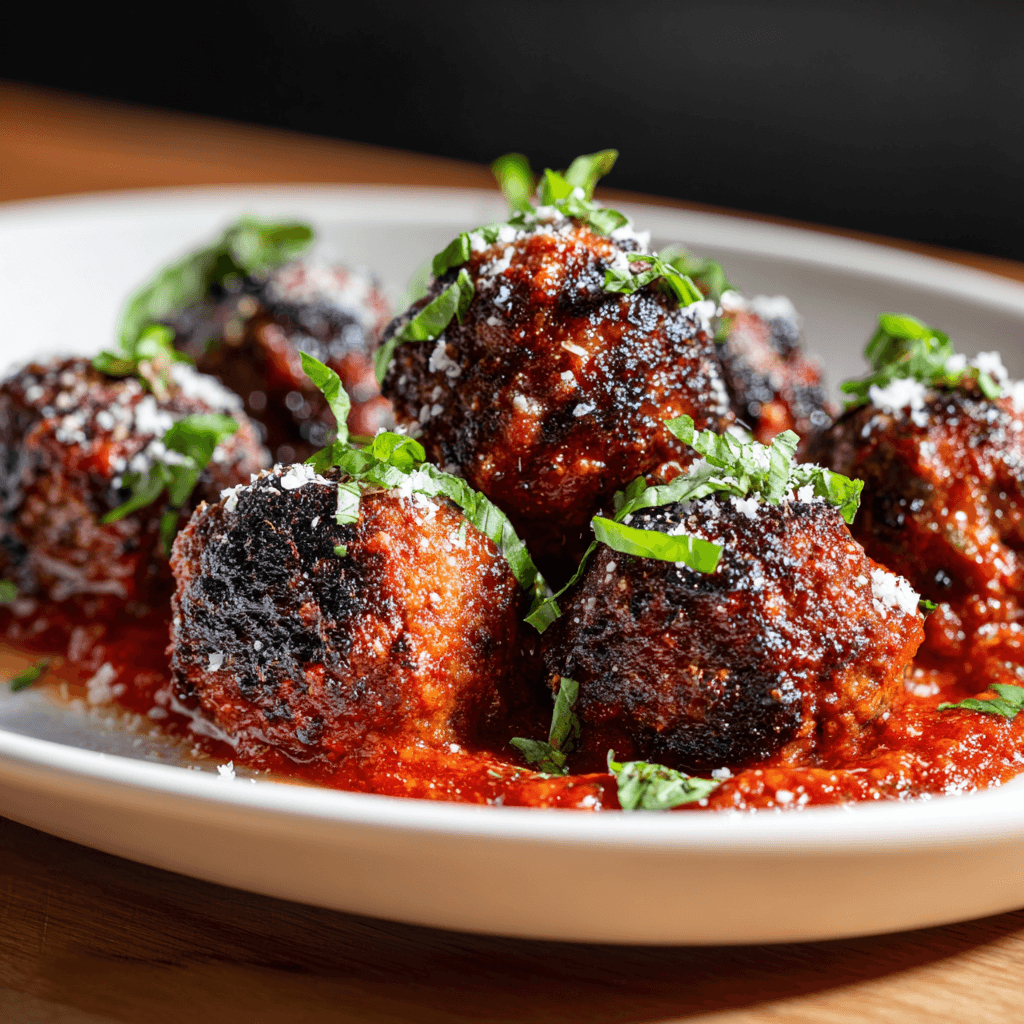Table of Contents
Gordon Ramsay Italian Meatballs represent the perfect fusion of technique and tradition that transforms simple ingredients into culinary gold. After twenty years responding to kitchen fires as a firefighter, I’ve learned that the biggest disasters often come from rushing the fundamentals – and meatballs are no exception. These aren’t your average cafeteria spheres of sadness; they’re tender, flavorful masterpieces that showcase why proper technique matters more than expensive ingredients. The FDA recommends cooking ground meat to 160°F for safety, but Gordon’s method ensures you hit that target while maintaining incredible moisture and flavor. This recipe pairs beautifully with his marinara sauce, creating a complete Italian experience that’ll have your family thinking you’ve been hiding culinary school credentials.
Why This Gordon Ramsay Italian Meatballs Recipe Works (And Where Most Go Wrong)
The genius of Gordon Ramsay Italian Meatballs lies in three core principles that most home cooks completely miss. First, the meat mixture ratio – Gordon uses a precise blend of ground beef, pork, and veal that creates optimal fat content and flavor complexity. Too many people grab whatever ground meat is on sale, then wonder why their meatballs taste like cardboard. Second, the panade technique – mixing breadcrumbs with milk creates a moisture-retaining paste that prevents the dreaded hockey puck syndrome. Most recipes just throw dry breadcrumbs in and call it done. Third, the gentle handling philosophy – overworking the meat develops tough proteins that create dense, chewy results. Food science shows that minimal mixing preserves tender texture while still achieving proper binding.
The Temperature Control Factor
Where most meatball attempts crash and burn is temperature management during cooking. Gordon’s method involves a two-stage process: gentle browning followed by slow simmering that ensures even cooking throughout while developing that essential Maillard reaction crust.
Ingredients That Actually Matter for Gordon Ramsay Italian Meatballs

Quality ingredients make the difference between amateur and professional results in Gordon Ramsay Italian Meatballs. The meat blend should be 1/3 each of ground beef chuck (20% fat), ground pork shoulder, and ground veal – this trinity provides optimal flavor and moisture retention. Chuck roast has enough fat to prevent dryness while maintaining beefy flavor. Pork shoulder adds richness and binding properties, while veal contributes delicate texture and subtle sweetness. For the panade, use day-old Italian bread – its texture absorbs liquid better than fresh bread without becoming gluey. Whole milk works better than skim because fat carries flavor and creates superior mouthfeel. Parmigiano-Reggiano aged at least 24 months delivers the nutty complexity that pre-grated cheese simply cannot match. Fresh herbs like parsley and basil brighten the mixture, while garlic and onion provide aromatic foundation. San Marzano tomatoes, if using for sauce, offer natural sweetness and proper acidity balance. The key substitution warning: avoid extra-lean ground meat at all costs – you need that fat content for proper texture and flavor development in your Italian cooking adventures.
Step-by-Step Instructions for Gordon Ramsay Italian Meatballs
Preparing the Panade Foundation
Start by tearing 2 slices of day-old Italian bread into small pieces, removing crusts. Soak in 1/2 cup whole milk for 10 minutes until completely saturated. This creates the moisture-retaining base that separates amateur from professional results. Gently squeeze out excess milk, leaving the bread paste moist but not dripping.
Creating the Meat Mixture
Combine 1 pound ground beef chuck, 1/2 pound ground pork shoulder, and 1/2 pound ground veal in a large mixing bowl. Add the prepared panade, 1/2 cup freshly grated Parmigiano-Reggiano, 1 beaten egg, 3 minced garlic cloves, 1/4 cup finely minced onion, 2 tablespoons chopped fresh parsley, 1 teaspoon salt, and 1/2 teaspoon black pepper. Using your hands, gently combine ingredients with a light folding motion – never squeeze or compact the mixture as this develops tough proteins that create dense meatballs.
Shaping and Initial Searing
With wet hands to prevent sticking, gently roll mixture into golf ball-sized portions, roughly 2 ounces each. Heat 2 tablespoons olive oil in a heavy-bottomed skillet over medium heat. Ensure oil reaches 350°F before adding meatballs to prevent sticking and ensure proper searing. Brown meatballs in batches, turning carefully with a spoon to develop even coloring on all sides – about 8-10 minutes total. The goal is surface browning, not complete cooking. Master this technique and you’ll excel at pasta preparations too.
Final Cooking Stage
Transfer browned meatballs to simmering marinara sauce. Cover and cook at gentle simmer for 20-25 minutes until internal temperature reaches 160°F. Avoid vigorous boiling which can break apart the delicate meatballs. The slow simmer allows flavors to meld while ensuring food safety standards. USDA guidelines confirm this temperature kills harmful bacteria while preserving texture.
Pro-Tips That Change the Game
- Chill formed meatballs for 30 minutes before cooking – this helps them hold their shape during the searing process
- Use a small ice cream scoop for perfectly uniform meatball sizing, ensuring even cooking throughout the batch
- Toast breadcrumbs lightly before making the panade for deeper flavor complexity and better texture control
- Add a tablespoon of ricotta cheese to the mixture for extra moisture and authentic Italian restaurant texture
- Reserve some pasta cooking water when serving – the starchy liquid helps bind sauce to meatballs and pasta perfectly
- Let meatballs rest in sauce for 5 minutes after cooking to allow flavors to marry and achieve optimal serving temperature
Storage & Leftovers for Gordon Ramsay Italian Meatballs
Store cooked Gordon Ramsay Italian Meatballs in the refrigerator for up to 4 days in airtight containers, keeping them submerged in sauce to prevent drying. For longer storage, freeze meatballs and sauce together in freezer-safe containers for up to 3 months. Thaw overnight in refrigerator before reheating. To reheat, warm gently in a covered saucepan over low heat, adding splash of water or broth if needed to prevent scorching. Microwave reheating works but tends to create tough texture – stovetop method preserves the original tender quality. Always ensure reheated meatballs reach 165°F internal temperature for food safety. The FDA food safety guidelines emphasize proper reheating temperatures to prevent foodborne illness while maintaining quality.

Gordon Ramsay Italian Meatballs
Ingredients
Equipment
Method
- 1️⃣ Tear 2 slices of day-old Italian bread into small pieces, removing crusts. Soak in 1/2 cup whole milk for 10 minutes until completely saturated. Gently squeeze out excess milk, leaving the bread paste moist but not dripping.
- 2️⃣ Combine ground beef chuck, ground pork shoulder, and ground veal in a large mixing bowl. Add the prepared panade, freshly grated Parmigiano-Reggiano, beaten egg, minced garlic, minced onion, chopped parsley, salt, and black pepper.
- 3️⃣ Using your hands, gently combine ingredients with a light folding motion. Never squeeze or compact the mixture as this develops tough proteins that create dense meatballs.
- 4️⃣ With wet hands to prevent sticking, gently roll mixture into golf ball-sized portions, roughly 2 ounces each. Chill formed meatballs for 30 minutes before cooking to help them hold their shape.
- 5️⃣ Heat olive oil in a heavy-bottomed skillet over medium heat. Ensure oil reaches 350°F before adding meatballs to prevent sticking and ensure proper searing.
- 6️⃣ Brown meatballs in batches, turning carefully with a spoon to develop even coloring on all sides, about 8-10 minutes total. The goal is surface browning, not complete cooking.
- 7️⃣ Transfer browned meatballs to simmering marinara sauce. Cover and cook at gentle simmer for 20-25 minutes until internal temperature reaches 160°F. Avoid vigorous boiling which can break apart the delicate meatballs.
- 8️⃣ Let meatballs rest in sauce for 5 minutes after cooking to allow flavors to marry and achieve optimal serving temperature before serving.
Nutrition
Notes
Tried this recipe?
Let us know how it was!Frequently Asked Questions About Gordon Ramsay Italian Meatballs
How does Gordon Ramsay cook meatballs?
Gordon Ramsay cooks meatballs using a two-stage method: first browning them in a hot skillet to develop flavor through the Maillard reaction, then finishing them by gentle simmering in sauce. This technique ensures even cooking while maintaining moisture and developing complex flavors. The key is avoiding aggressive heat that can break apart the delicate mixture.
How does Ramsay keep meatballs moist?
Ramsay keeps meatballs moist through the panade technique – bread soaked in milk that retains moisture during cooking. He also uses a proper meat blend with adequate fat content, handles the mixture gently to avoid developing tough proteins, and finishes cooking in sauce rather than dry heat. These Gordon Ramsay Italian Meatballs stay tender through scientific technique, not luck.
What are 5 interesting facts about Gordon Ramsay?
Gordon Ramsay originally trained as a soccer player before knee injuries ended his athletic career. He holds 16 Michelin stars across his restaurant empire and has completed multiple marathons and triathlons. Ramsay served as a Royal Navy honorary officer and learned classical French cooking under legendary chefs like Marco Pierre White. His television career spans multiple countries with shows translated into dozens of languages worldwide.
What not to do when making meatballs?
Never overwork the meat mixture as this develops tough glutens that create dense, chewy results. Avoid using extra-lean ground meat which lacks the fat necessary for moisture and flavor. Don’t skip the panade step or substitute dry breadcrumbs for the milk-soaked bread paste. Never cook meatballs at high heat throughout the entire process, and avoid making them too large as they won’t cook evenly. Finally, don’t serve Gordon Ramsay Italian Meatballs immediately after cooking – let them rest in sauce to absorb flavors. Consider pairing with our garlic bread recipe for the complete experience.
These Gordon Ramsay Italian Meatballs prove that professional techniques can be mastered in any home kitchen with proper guidance and attention to detail. The combination of quality ingredients, scientific understanding, and careful execution transforms simple ground meat into restaurant-quality results that’ll impress family and friends alike.
Stay safe,
Jack Sullivan


